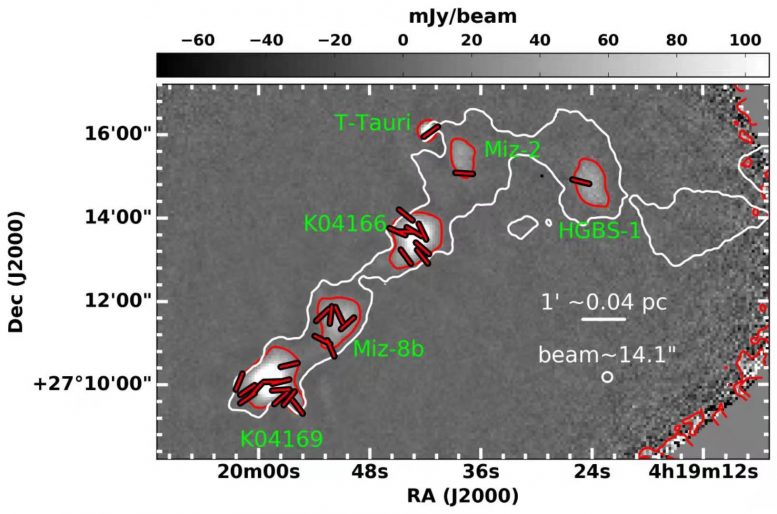
Core-scale magnetic fields (red segments) inferred using high-resolution and sensitive dust emission polarization observations using JCMT. The Solar-type star forming cores fragmented out of B213 filament are shown. Credit: Eswaraiah Chakali, et al. 2021
Magnetic fields are ubiquitous throughout our Milky Way Galaxy and play a crucial role in all dynamics of interstellar medium. However, questions like how Solar-type stars form out of magnetized molecular clouds, whether the role of magnetic fields changes at various scales and densities of molecular clouds, and what factors can change the morphology of magnetic fields in low-mass dense cores still remain unclear.
A new study led by Dr. Eswaraiah Chakali from Prof. LI Di’s research group at the National Astronomical Observatories of the Chinese Academy of Sciences (NAOC) has partially answered these questions. The study reveals the diverse magnetic field morphologies in Solar-type star forming cores in the Taurus B213 region.
This study was recently published in The Astrophysical Journal Letters.
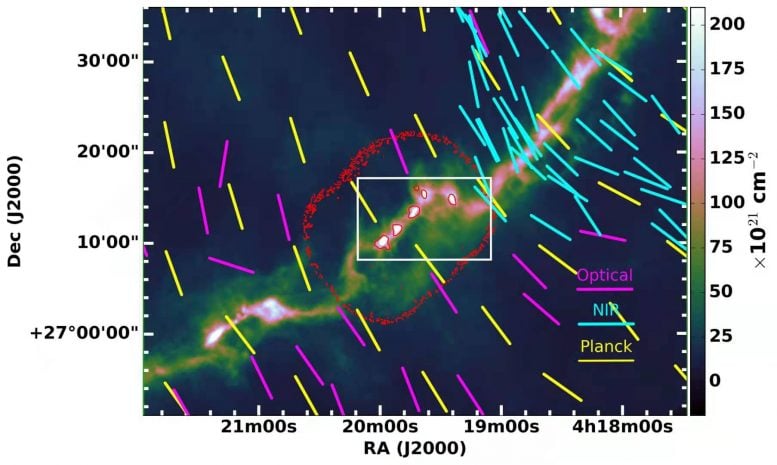
Large-scale, uniform magnetic field morphology of Taurus/B213 region, inferred based on multi-wavelength polarization data. The extent of Fig. 1 is marked with a white box. Credit: Eswaraiah Chakali, et al. 2021
The researchers used high-resolution and sensitive 850-micron dust emission polarization data acquired by the James Clerk Maxwell Telescope (JCMT) using the SCUBA-2 camera along with the POL-2 polarimeter.
The observations were conducted as a part of a large international program called B-fields In STar-forming Region Observations (BISTRO).
“Although formed out of the same filamentary cloud, Taurus/B213, among the three dense cores having more polarization measurements, only one remembers the relatively uniform large-scale magnetic field threading the parental cloud,” said Dr. Eswaraiah Chakali, lead author of the study.
This is in contrast to expectations based on the theory that magnetic fields regulate star formation. If a large-scale magnetic field dominates throughout cloud accumulation, core collapse, and star formation, the mean position angle of the magnetic field should be similar across various spatial scales.
Further analysis of the gas velocity gradient revealed that the kinematics due to gas accretion flows onto the parental filament could have altered the magnetic field configuration.
“Even in the presence of substantial magnetic flux, local physical conditions can significantly affect magnetic field morphology and their role in star formation,” said Prof. LI Di, co-corresponding author of the study.
“Our current observations represent one of the deepest sub-millimeter polarimetry images ever taken using a single dish telescope toward a Galactic region,” said Prof. QIU Keping of Nanjing University, co-PI of the BISTRO project and a coauthor of the study.
Prof. LI Di also highlighted “more comprehensive analyses, in combination with Planck data and stellar polarimetry, may give more insights into the evolution of magnetic fields in this stereotypical low-mass star-forming region.”
Reference: “The JCMT BISTRO Survey: Revealing the Diverse Magnetic Field Morphologies in Taurus Dense Cores with Sensitive Submillimeter Polarimetry” by Chakali Eswaraiah, Di Li, Ray S. Furuya, Tetsuo Hasegawa, Derek Ward-Thompson, Keping Qiu, Nagayoshi Ohashi, Kate Pattle, Sarah Sadavoy, Charles L. H. Hull, David Berry, Yasuo Doi, Tao-Chung Ching, Shih-Ping Lai, Jia-Wei Wang, Patrick M. Koch, Jungmi Kwon, Woojin Kwon, Pierre Bastien, Doris Arzoumanian, Simon Coudé, Archana Soam, Lapo Fanciullo, Hsi-Wei Yen, Junhao Liu, Thiem Hoang, Wen Ping Chen, Yoshito Shimajiri, Tie Liu, Zhiwei Chen, Hua-bai Li, A-Ran Lyo, Jihye Hwang, Doug Johnstone, Ramprasad Rao, Nguyen Bich Ngoc, Pham Ngoc Diep, Steve Mairs, Harriet Parsons, Motohide Tamura, Mehrnoosh Tahani, Huei-Ru Vivien Chen, Fumitaka Nakamura, Hiroko Shinnaga, Ya-Wen Tang, Jungyeon Cho, Chang Won Lee, Shu-ichiro Inutsuka, Tsuyoshi Inoue, Kazunari Iwasaki, Lei Qian, Jinjin Xie, Dalei Li, Hong-Li Liu, Chuan-Peng Zhang, Mike Chen, Guoyin Zhang, Lei Zhu, Jianjun Zhou, Philippe André, Sheng-Yuan Liu, Jinghua Yuan, Xing Lu, Nicolas Peretto, Tyler L. Bourke, Do-Young Byun, Sophia Dai, Yan Duan, Hao-Yuan Duan, David Eden, Brenda Matthews, Jason Fiege, Laura M. Fissel, Kee-Tae Kim, Chin-Fei Lee, Jongsoo Kim, Tae-Soo Pyo, Yunhee Choi, Minho Choi, Antonio Chrysostomou, Eun Jung Chung, Le Ngoc Tram, Erica Franzmann, Per Friberg, Rachel Friesen, Gary Fuller, Tim Gledhill, Sarah Graves, Jane Greaves, Matt Griffin, Qilao Gu, Ilseung Han, Jennifer Hatchell, Saeko Hayashi, Martin Houde, Koji Kawabata, Il-Gyo Jeong, Ji-hyun Kang, Sung-ju Kang, Miju Kang, Akimasa Kataoka, Francisca Kemper, Mark Rawlings, Jonathan Rawlings, Brendan Retter, John Richer, Andrew Rigby, Hiro Saito, Giorgio Savini, Anna Scaife, Masumichi Seta, Gwanjeong Kim, Kyoung Hee Kim, Mi-Ryang Kim, Florian Kirchschlager, Jason Kirk, Masato I. N. Kobayashi, Vera Konyves, Takayoshi Kusune, Kevin Lacaille, Chi-Yan Law, Sang-Sung Lee, Yong-Hee Lee, Masafumi Matsumura, Gerald Moriarty-Schieven, Tetsuya Nagata, Hiroyuki Nakanishi, Takashi Onaka, Geumsook Park, Xindi Tang, Kohji Tomisaka, Yusuke Tsukamoto, Serena Viti, Hongchi Wang, Anthony Whitworth, Hyunju Yoo, Hyeong-Sik Yun, Tetsuya Zenko, Yapeng Zhang, Ilse de Looze, C. Darren Dowell, Stewart Eyres, Sam Falle, Jean-François Robitaille and Sven van Loo, 10 May 2021, The Astrophysical Journal Letters.
DOI: 10.3847/2041-8213/abeb1c



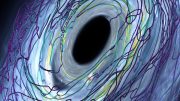
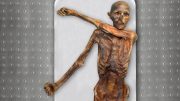
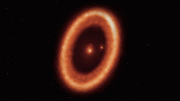
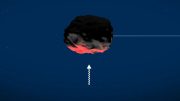
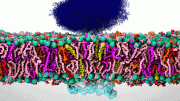

Be the first to comment on "Diverse Magnetic Fields Revealed in Solar-Type Star-Forming Cores"